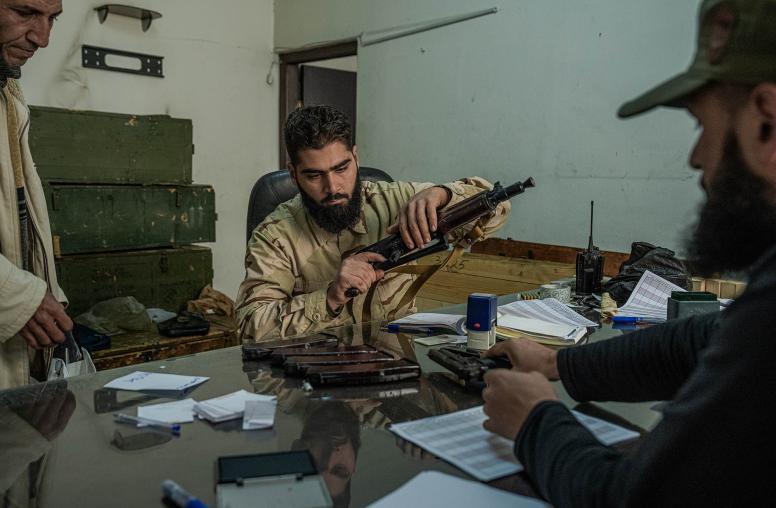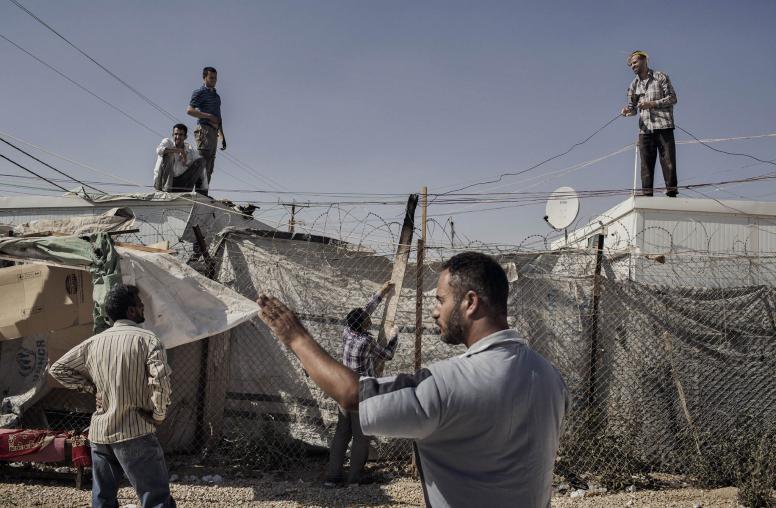Humanitarian Aid: ‘Radical Change’ After Istanbul?
World Humanitarian Summit May Mark a Start Toward Overhaul
The two-day World Humanitarian Summit held recently in Istanbul drew criticism for the absence of top global leaders, but it actually broke ground in several ways, experts said in a discussion hosted by the U.S. Institute of Peace and Oxfam America. The summit spotlighted the need for “radical change” in a relief system built for the era after World War II rather than today’s small wars, insurgencies and fragmenting states that have unleashed the second-biggest flood of displaced people in history, said Ray Offenheiser, the president of Oxfam America.

The lumbering bureaucracies and centralized decision-making that manage humanitarian assistance are badly in need of reform, Offenheiser said in summarizing points made in the discussion, which included U.S. officials and representatives of non-government organizations. The Istanbul meeting, despite its shortcomings, marked a good start toward change, he said, in part because it brought together thousands of partners from civil society and gave groups once excluded from such deliberations a place in the reform dialogue.
Nancy Lindborg, the president of USIP, noted that a decade ago, 80 percent of spending on humanitarian need went to recovery from natural disasters, and 20 percent to handling results of violent conflict; the ratio today is reversed.
“This summit for the first time put politics and poor governance at the heart of today’s crises,” said Lindborg, who attended the United Nations-convened gathering. The summit showed that “peacebulding is no longer the domain of just governments and diplomats,” and brought clear focus to the growing—and necessary—confluence of humanitarian and development strategies, she said.
Offenheiser in his summary noted that the summit seemed to many observers and participants to be too much of a “talk shop,” largely because the world leaders who will need to drive major change didn’t show up. And while 1,500 commitments were made in various forums of the summit, they are still being sorted out. “What they mean remains to be seen,” he said.
“This is the year of humanitarianism,” Offenheiser said.
The Istanbul meeting helped lay groundwork for the UN General Assembly’s High-Level Meeting on Addressing Large Movements of Refugees and Migrants to be held on Sept. 19. On Sept. 20, President Barack Obama will host a leaders summit on refugees on the sidelines of the General Assembly, a meeting that the president said will give world leaders a chance to increase their commitments to expanding opportunities for refugees and supporting frontline states.
“There’s a lot of summits going on this year, and I think they represent a kind of collective yearning to fix something,” said Elizabeth Ferris, a professor at Georgetown University’s School of Foreign Service and a senior adviser to the September U.N. General Assembly High-Level Meeting. “Clearly, we haven’t got it right yet.”
In discussing the summit and how the international humanitarian system can be strengthened, the panelists expressed the following points:
Finding new sources of financial support for humanitarian work is critical.
The current humanitarian system is overstretched and under-resourced; the U.N.’s goal of $19.3 billion in funding for global humanitarian responses in 2015 was only 54 percent fulfilled. The 2016 appeal seeks $20.1 billion, an almost 10-fold increase over the level in 2000. The summit Obama will convene is where “the real money” will be raised, said Anne Richard, who heads the State Department’s Bureau of Population, Refugees and Migration. It will be modeled on last year’s peacekeeping summit, which resulted in increased pledges for troops and materiel.
Governments also need to think more creatively about how to produce their own resources to invest in preparedness and resilience at the country level, Offenheiser said.
“We’re not going to have the money unless we completely rethink the financing,” he said. While overseas development aid to needy nations is declining, it accounts for only 8 percent of money coming in. The rest includes foreign direct investment, remittances and equity and other private-sector investment, all of which are growing.
“These countries need to assume some responsibility for their own financing through effective tax systems,” Offenheiser said. Anwar Kahn, the CEO of Islamic Relief USA, cited a telethon in Pakistan that raised $100 million. “There is money there,” Kahn said. “We need to be more efficient. We cannot be writing blank checks anymore.”
Local actors must get more support and be given decision-making power.
Local groups are the first responders in humanitarian disasters and remain on the ground in the aftermath. Yet international organizations often come in and “crush them,” Offenheiser said. Shifting more responsibility to locally based people is a major “mind shift” for big, international organizations, one he said Oxfam has made in funding 4,000 nonprofits around the world.
At the summit in Istanbul, a commitment was made to support a “local empowerment agenda” and to channel 25 percent of aid through local groups, up from less than 1 percent.
“There’s a feeling that U.N. organizations are designed as a big bureaucracy, giving money to big aid agencies and not reaching out to the locals,” Kahn said. Yet fulfilling the 25 percent goal would exceed the management capacity of local organizations, he said, so that kind of shift will also require investment in the organizations themselves.
Strengthening the humanitarian system demands a more inclusive approach.
The Network for Empowered Aid Response, a grouping of national and local organizations, was unveiled on the eve of the summit to promote innovations and views often overlooked by international players. The post-World War II humanitarian aid system was designed by “people who were white” at a time the global South was under colonial domination, Kahn said. The summit in Istanbul was the South’s opportunity, 70 years later, to discuss humanitarian principals as a partner, he said. As an example, he said, ideologically based ideas that were brushed aside years ago, such as giving cash grants to widows to help restart an economy, are now viewed as having value.
The Syrian view on humanitarian aid is bleak.
“I do not share the optimism about the summit expressed by others on this panel,” said Fadi Halliso, the CEO and co-founder of Basmeh and Zeitooneh, an organization serving Syrian refugees in Turkey and Lebanon. The international community has failed to protect Syrian civilians caught up in the country’s civil war, he said.
“We go from conferences to workshops to summits where amazing pledges are made, and very little takes place,” he said. “There is a lot of nice talk about empowering local actors. This is not happening,” he said, citing a report that only 0.3 percent of the $2.1 billion spent on Syrian refugees in 2014 went directly to Syrian aid groups. What is the point of having summits, pledges and commitments if no one can impose accountability, he asked. The absence of major world leaders in Istanbul signaled that there won’t be any change, he concluded.
Relief efforts need to be more nimble and effective.
The U.N. faces an historic number of simultaneous crises, making overhaul of the system an imperative, Offenheiser said. Sometimes a massive international effort will be needed, but more must be done to prepare for natural disasters and to prevent and mitigate violent conflicts, which Lindborg noted now cause most of the need for most humanitarian relief.
More flexibility in responses, coordination by relief organizations and integration of goals are needed to focus on the root causes of humanitarian disasters, said Thomas Staal, the acting chief of the Bureau for Democracy, Conflict and Humanitarian Assistance at the U.S. Agency for International Development. That includes more closely aligning humanitarian and development assistance, he said.
“We also need to look at the private sector,” Staal said. “It can bring lots of energy and ideas that serve their business interests.”
Climate change is a new challenge that blurs the lines between humanitarian and development aid.
The “slow onset emergency” of climate change demands combining development and humanitarian work and makes limitations on funding by those categories obsolete, Offenheiser said. Ferris said after 25 years of debate on the development/humanitarian question, the Istanbul summit highlighted a growing understanding that both sit on a continuum. Still, only 0.4 percent of overseas development aid is applied to reducing the risks of disasters, Offenheiser said. That’s too little to help local organizations strengthen their ability to help.
The U.S. leadership in aid will persist—even as the direction of assistance changes.
As the largest donor of humanitarian aid, the U.S. can lead in reshaping aid on issues such as those highlighted at the summit, Staal said. The U.S. is best-positioned to enhance coordination among donors and implement administrative reform, he said. On international humanitarian law reforms, the U.S. has the heft to lead other nations, he said.


